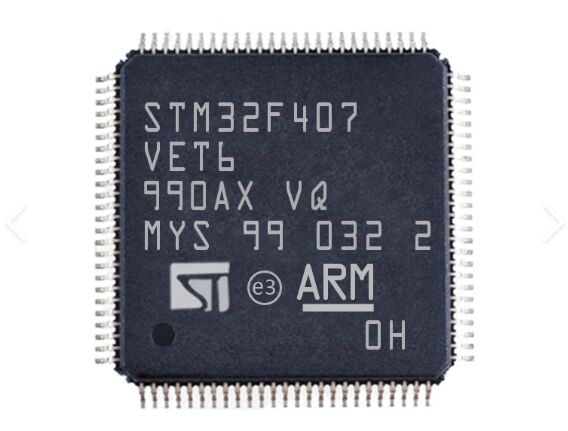By STMicroelectronics 148
STM32F407VET6 is a 32-bit microcontroller produced by STMicroelectronics (ST) and belongs to the STM32F4 series. This series uses the ARM Cortex-M4 core and is widely used in various embedded systems and applications, including industrial control, automotive electronics, consumer electronics, etc.
The STM32F407VET6 array includes high-speed embedded memory (up to 1MB Flash, up to 192KB SRAM), up to 4KB backup SRAM, and connectivity to two APB buses, three AHB buses and a 32-bit multi-AHB bus matrix. In addition, all STM32F407VET6 devices provide three 12-bit ADCs, two DACs, a low-power RTC and twelve general-purpose 16-bit timers, including two PWM timers for motor control, two general-purpose 32-bit timers It also has standard and advanced function communication interfaces.

Ⅰ.Specifications of STM32F407VET6
•Series:STM32F407VE
•Number of pins:100
•Product category:ARM microcontroller-MCU
•Installation style:SMD/SMT
•Package/Case:LQFP-100
•Program memory size:512 kB
•Data bus width:32 bit
•ADC resolution:12 bit
•Maximum clock frequency:168 MHz
•Number of input/output terminals:82 I/O
•Data RAM size:192 kB
•Supply voltage-minimum:1.8 V
•Supply voltage-Max:3.6 V
•Minimum operating temperature:-40℃
•Maximum operating temperature:+85℃
•Package:Tray
•DAC resolution:12 bit
•Data Ram type:SRAM
•Interface type:CAN, I2C, SDIO, I2S/SPI, UART/USART, USB
•Number of ADC channels:16 Channel
•Product type:ARM Microcontrollers-MCU
•FLASH memory capacity:512 KB
•Length:14.2 mm
•Width:14.2 mm
•Height:1.45 mm
•RAM size:192Kx8
•Data converter:A/D16x12b; D/A2x12b
•Speed:168MHz
Ⅲ.Current consumption measurement scheme of STM32F407VET6

Ⅳ.Voltage characteristics of STM32F407VET6

Ⅴ.How to connect and use STM32F407VET6 peripherals
1.Pin configuration: Use STM32CubeMX or other configuration tools to configure the pins of the microcontroller to connect the required peripherals. Select appropriate pins as peripheral data lines, clock lines, etc. Make sure the pin configuration matches the peripheral's requirements.
2.Initialize peripherals: Initialize the selected peripherals in code. Use libraries provided by ST (such as HAL library) or write low-level register configuration code directly. Common peripheral initialization steps:
•SPI:
•Initialize SPI peripherals and set parameters such as clock polarity, phase, and data bits.
•Configure Master/Slave mode.
•Enable corresponding interrupts (if required).
•UART (serial port):
•Enable corresponding interrupts (if required).
•Initialize send and receive buffers.
•Initialize UART peripherals and set parameters such as baud rate, data bits, stop bits, etc.
•I2C:
•Configure as master or slave mode.
•Enable corresponding interrupts (if required).
•Initialize I2C peripherals and set parameters such as clock rate and address mode.
3.Error handling: Consider adding an error handling mechanism to handle errors that may occur during peripheral transmission. This may include parity errors, framing errors, etc.
4.Data transmission: Once the peripherals are initialized, you can start using them for data transmission. This includes sending and receiving data, which may involve polling or interrupt/DMA, depending on your application needs.
Ⅵ.Working principle of STM32F407VET6
1.Main control part: The main control part provides circuits related to the microcontroller. These circuits are responsible for handling the core functions of the microcontroller.
2.Power supply part: STM32F407VET6 provides a stable operating voltage through the power supply part, which is the basis for the normal operation of the microcontroller.
3.Peripheral part: The peripheral part provides various peripheral functions, such as ADC, DAC, RTC, timer, etc. These peripheral functions allow the microcontroller to communicate with and control external devices.
4.Connector part: The connector part provides interfaces to external devices, such as GPIO, UART, SPI, etc. Through these interfaces, the microcontroller can exchange data and control operations with external devices.
Ⅶ.What is the interrupt mechanism of STM32F407VET6?
•The interrupt mechanism of STM32F407VET6 is a processing method. When an event (such as a change in input signal) occurs, it will break the current processing flow of the microcontroller and direct it to another preset code area for processing. This mechanism allows the microcontroller to respond quickly to external events or to perform specific tasks when specific events occur.
•In STM32F407VET6, the interrupt mechanism is controlled by the Nested Vectored Interrupt Controller (NVIC). NVIC can manage internal and external interrupts. Internal interrupts are usually generated by peripherals or interfaces within the microcontroller, such as timers or serial communications. External interrupts are generated by external devices independent of the microcontroller, such as buttons or wireless modules.
•When an interrupt source (such as a button press) triggers an interrupt, the microcontroller will pause the currently executing program, jump to the scheduled interrupt handler, and return to the original interrupted place to continue execution after the processing is completed.
•Interrupts can also be divided into synchronous interrupts and asynchronous interrupts. Synchronous interrupts are generated by instructions being executed, while asynchronous interrupts are randomly generated by other hardware devices in accordance with the CPU clock signal.
•In general, the interrupt mechanism of STM32F407VET6 allows it to respond quickly to various events, which is very important for realizing real-time control, multi-tasking and other functions.
Ⅷ.Application fields of STM32F407VET6
1.Communication equipment: STM32F407VET6 has a wide range of applications in the communication field. Due to its powerful processing capabilities and rich peripheral interfaces, it can be used in various communication devices and systems to support data transmission and communication protocols. For example, it can serve as the control core of communication equipment such as network equipment, routers or switches, processing and forwarding data packets, managing network connections, etc. By connecting to various communication interfaces (such as UART, SPI, I2C, etc.), STM32F407VET6 can communicate with other devices or modules to realize data transmission and control.
2.Industrial automation: STM32F407VET6 has important application value in the field of industrial automation. In industrial control systems, microcontrollers play a key role, responsible for real-time control and monitoring of various industrial equipment. The powerful processing capabilities of STM32F407VET6 enable it to quickly process various control algorithms and complex tasks, thereby accurately controlling industrial equipment such as motor drives and PLCs. This helps achieve efficient and accurate automated production processes. Secondly, through rich peripheral interfaces, STM32F407VET6 can be easily connected to various sensors and actuators to collect and output control signals in real time. For example, it can read sensor data to monitor the status of industrial equipment, or output control signals to drive actuators to realize automated operation of equipment. In addition, the reliability and stability of STM32F407VET6 enable it to operate stably for a long time in industrial environments. At the same time, it also supports a variety of communication protocols, such as Modbus, Profibus, etc., to facilitate communication and control with other industrial equipment.
3.Consumer electronics: STM32F407VET6 is also widely used in the field of consumer electronics. Due to its high performance and rich peripheral interfaces, it can provide powerful control and data processing capabilities for various consumer electronics products. In smart home devices, STM32F407VET6 can be used as the main controller to manage various functions of home devices. For example, it can read sensor data, control home appliances, communicate with the cloud, etc., to provide users with an intelligent home experience. Among audio devices, STM32F407VET6 can achieve high-quality audio input and output through its audio interface. It can also be used to process audio signals, implement sound effects processing, audio encoding and decoding and other functions.
4.Medical equipment: Medical equipment usually requires high precision, reliability and stability, and the features and functions of STM32F407VET6 can exactly meet these requirements. The powerful processing capabilities of STM32F407VET6 enable it to quickly handle various algorithms and control tasks for medical equipment. For example, in an electrocardiograph, it can process ECG signals through algorithms to provide accurate diagnostic information. The low power consumption of the STM32F407VET6 makes it particularly suitable for portable medical devices such as blood pressure monitors and blood glucose meters. These devices usually need to work for a long time, and STM32F407VET6 can reduce power consumption while ensuring performance, thereby extending the battery life of the device.
5.Automotive electronics: STM32F407VET6 has excellent performance and stability and can operate stably in the harsh working environment of automobiles. It also has low power consumption features that help extend the life of your car battery. STM32F407VET6 has rich peripheral interfaces and can be connected to various sensors and actuators of the car to achieve efficient data collection and control. For example, it can read sensor data such as vehicle speed, engine speed, temperature, etc., and then adjust vehicle performance by controlling the engine or braking system.
6.Internet of Things (IoT): STM32F407VET6 also has important application value in the field of Internet of Things. With the rapid development of Internet of Things technology, more and more embedded devices are required to be connected to the Internet to realize data collection, transmission and processing. The features and functions of STM32F407VET6 exactly meet these needs. The low power consumption of the STM32F407VET6 makes it particularly suitable for IoT devices, especially those that need to operate for long periods of time or are battery powered. By optimizing power management, it can extend the battery life of the device while ensuring stable performance.
7.Aerospace: STM32F407VET6 has excellent stability and reliability and can operate normally in extreme working environments. This makes it ideal for critical parts such as flight control systems and navigation systems. STM32F407VET6 has high-speed processing capabilities and rich peripheral interfaces, and can efficiently handle flight control algorithms, navigation data and other complex tasks. By interfacing with other avionics equipment, real-time data collection, transmission and command issuance can be achieved. STM32F407VET6 also supports a variety of communication protocols, such as UART, SPI, I2C, etc., as well as wireless communication protocols such as WiFi and Bluetooth, enabling seamless integration and communication with other systems. This helps improve the overall performance and interoperability of aerospace systems.
Frequently Asked Questions
1.What is the power supply voltage of STM32F407VET6?
The power supply voltage of STM32F407VET6 is 3.3V.
2.Does STM32F407VET6 have ADC?
Yes, STM32F407VET6 has ADC.
3.How does STM32F407VET6 handle interrupts?
First introduce the necessary header files, configure the interrupt service function, configure peripherals and interrupts, then enable global interrupts, enter the main loop, and finally write the interrupt service function.